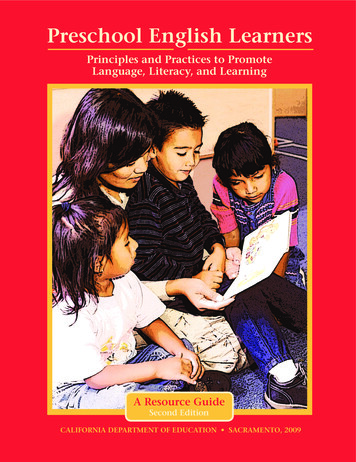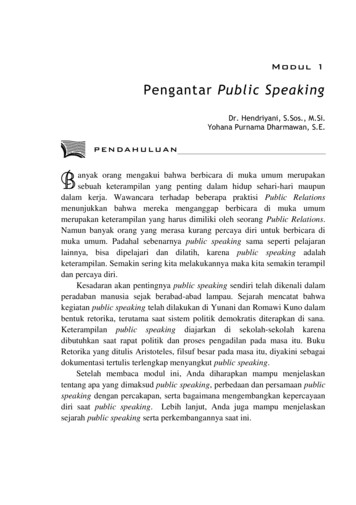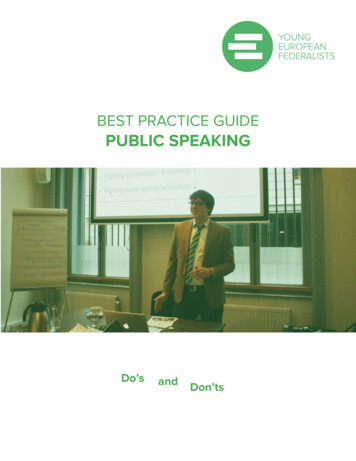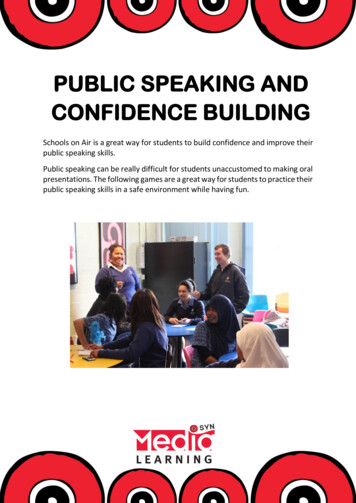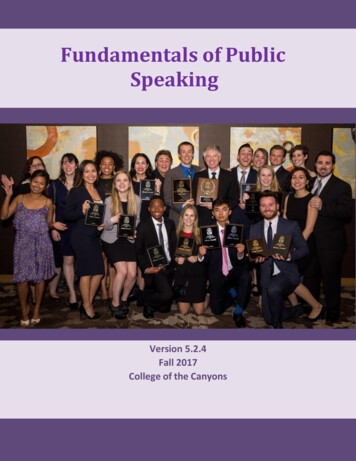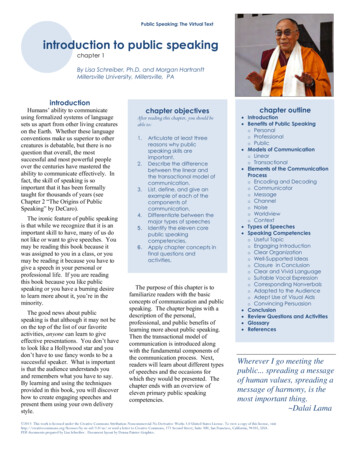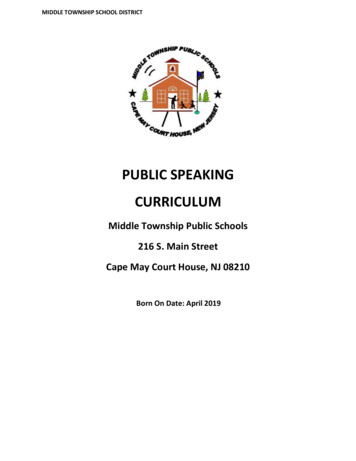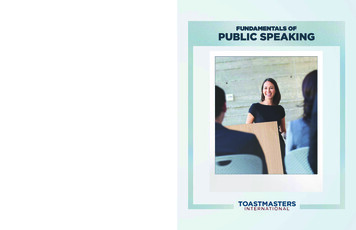
Transcription
FUNDAMENTALS OFPUBLIC SPEAKING FUNDAMENTALS OFPUBLIC SPEAKINGTOASTMASTERS INTERNATIONAL
TABLE OF CONTENTSINTRODUCTION TO THE TOASTMASTERSEDUCATION PROGRAM . . . . . . . . . . . . . . . . . . . . . . . . . . . . . . . . . . . . . . . . . . . . . . . . . . . . . . . . . . 2YOUR FIRST SPEECH—THE ICE BREAKERAssignment . . . . . . . . . . . . . . . . . . . . . . . . . . . . . . . . . . . . . . . . . . . . . . . . . . . . . . . . . . . . . . . . . . . . . . . 2Competencies . . . . . . . . . . . . . . . . . . . . . . . . . . . . . . . . . . . . . . . . . . . . . . . . . . . . . . . . . . . . . . . . . . . . 2Prepare and Present . . . . . . . . . . . . . . . . . . . . . . . . . . . . . . . . . . . . . . . . . . . . . . . . . . . . . . . . . . . . . . . 3YOUR SECOND SPEECH—ORGANIZE YOUR SPEECHAssignment . . . . . . . . . . . . . . . . . . . . . . . . . . . . . . . . . . . . . . . . . . . . . . . . . . . . . . . . . . . . . . . . . . . . . . . 3Competencies . . . . . . . . . . . . . . . . . . . . . . . . . . . . . . . . . . . . . . . . . . . . . . . . . . . . . . . . . . . . . . . . . . . . 3The Value of Organization . . . . . . . . . . . . . . . . . . . . . . . . . . . . . . . . . . . . . . . . . . . . . . . . . . . . . . . . . 4Creating Your Speech . . . . . . . . . . . . . . . . . . . . . . . . . . . . . . . . . . . . . . . . . . . . . . . . . . . . . . . . . . . . . 4A Complete Outline . . . . . . . . . . . . . . . . . . . . . . . . . . . . . . . . . . . . . . . . . . . . . . . . . . . . . . . . . . . . . . . 4Preparing Your Speech . . . . . . . . . . . . . . . . . . . . . . . . . . . . . . . . . . . . . . . . . . . . . . . . . . . . . . . . . . . . 5Your Evaluation . . . . . . . . . . . . . . . . . . . . . . . . . . . . . . . . . . . . . . . . . . . . . . . . . . . . . . . . . . . . . . . . . . . 6YOUR THIRD SPEECH—EVALUATION AND FEEDBACKAssignment . . . . . . . . . . . . . . . . . . . . . . . . . . . . . . . . . . . . . . . . . . . . . . . . . . . . . . . . . . . . . . . . . . . . . . . 6Competencies . . . . . . . . . . . . . . . . . . . . . . . . . . . . . . . . . . . . . . . . . . . . . . . . . . . . . . . . . . . . . . . . . . . . 6Preparing to Evaluate . . . . . . . . . . . . . . . . . . . . . . . . . . . . . . . . . . . . . . . . . . . . . . . . . . . . . . . . . . . . . 7Supporting Speakers Through Evaluation . . . . . . . . . . . . . . . . . . . . . . . . . . . . . . . . . . . . . . . . . . 7MAKING THE MOST OF YOUR TIME AS A CHARTER CLUB . . . . . . . . . . . . . 7SPEECH OUTLINE WORKSHEET . . . . . . . . . . . . . . . . . . . . . . . . . . . . . . . . . . . . . . . . . . . . . . 8Rev. 11/2016 Item 8955 2016 Toastmasters International. All rights reserved. Toastmasters International, the Toastmasters International logo, and all other ToastmastersInternational trademarks and copyrights are the sole property of Toastmasters International and may be used only with permission.
INTRODUCTION TO THETOASTMASTERS EDUCATION PROGRAMMToastmasters International has a long tradition of building communication and leadership skills.First and foremost, Toastmasters is about the club experience. The opportunities to learn throughparticipation are great and many members build friendships that last a lifetime.To support learning, Toastmasters has a comprehensive, personalized education program.The three projects included in this manual will introduce you and other club members to the styleof learning as well as the types of projects in the current education program and the ToastmastersPathways learning experience.The program is self-paced. You are in control of scheduling your speeches and when youcomplete your projects. Some new members are ready to start speaking right away and othersneed time to feel comfortable enough to present at a club meeting. All members are invited andencouraged to participate in Table Topics and to fulfill meeting roles when they feel ready todo so.The following projects are based on Pathways projects designed for members of chartering clubs. You may do the projects in any order, though it is best to begin with the Ice Breakerbecause it is an opportunity to introduce yourself to members of your club.As you launch your Toastmasters journey, you are taking an important step toward accomplishing your goals.ENTORPBARYOUR FIRST SPEECH—THE ICE BREAKER*SET 4 – AASMSpeech Length: Four to six minutesBA2 FUNDAMENTALS OF PUBLIC SPEAKINGSET 5– ARE Recognize the elements of basicspeech structure. Balance preparation and spontaneitywhen delivering your speech.Purpose: The purpose of this project is tointroduce yourself to the club and learn thebasic structure of a public speech.Overview: Write and deliver a speechabout any topic to introduce yourself toyour club. Your speech may be humorous, informational, or any other style thatappeals to you.GGCOMPETENCIES:Ice BreakerThe following are competencies you willpractice in this project.ODASSIGNMENTMentor
PREPARE AND PRESENTEvery person who ever joined a Toastmasters club gave an Ice Breaker speech. It is designed toprovide you with a topic that is easy to remember, familiar, and comfortable. It has the addedbenefit of introducing you to your club members.Your speech can cover any part of your life. Some members choose to explain the reasonsthey decided to join a Toastmasters club. Others share an important part of their lives, like theircareers or hobbies. What you speak about is completely at your discretion.Your speech will need an opening, a body, and a conclusion. As you consider what to include,keep in mind that the length of the speech is four to six minutes. Be sure to practice your speechin front of a mirror, present it to a family member or friend to get their feedback, and if possible,record your speech and watch it to help fine-tune your presentation.You are welcome to complete the full Ice Breaker project online at www.toastmasters.org/Pathways. It includes resources and an evaluation resource that your evaluator can use to provideyou with feedback. If you choose to complete the Ice Breaker online, you will receive credit forcompleting your first speech in Pathways!*An important note about the Ice Breaker project: If you choose to complete the full version of the projectonline, you will fulfill the Level 1 requirement for the Ice Breaker project when your club charter is complete and you haveaccess to Pathways. Please submit the Ice Breaker Project Completion Request form found at www.toastmasters.org/PathwaysForms to your vice president education for verification prior to submitting to World Headquarters.YOUR SECOND SPEECH—ORGANIZE YOUR SPEECHHaving experienced what it is like to present to an audience by completing yourfirst speech as well as contributing to TableTopics, you are ready to concentrate on thestructure of an effective speech. It is timeto focus on how to organize your ideas andfollow an outline from beginning to end.ASSIGNMENTPurpose: The purpose of this project is topractice organizing and presenting a speech.Overview: You may choose any topic. Besure it is specific enough to present in afive- to seven-minute speech. Organize yourspeech and present it to your club. Yourspeech may be humorous, informational, orany other style that appeals to you.COMPETENCIES:The following are competencies you willpractice in this project. Organize your speech clearly to maximizeaudience understanding. Craft clear and engaging transitionsbetween main sections of your speech.Speech Length: Five to seven minutesTOASTMASTERS INTERNATIONAL 3
THE VALUE OF ORGANIZATIONAn organized speech will help your audience follow yourthoughts and ideas from the opening line through to yourconcluding statement. A well-organized speech containsideas that link together in a cohesive way to ensure yourcontent supports your topic.As you create your outline and design your speech,think of your audience members’ points of view. Mostpeople are highly motivated by their personal needs, notnecessarily by the needs of others. Analyze how you canencourage audience members to see your point of view,understand what you are asking or communicating, and take action if necessary. Let your understanding of your audience guide the creation of your speech.CREATING YOUR SPEECHEvery speech needs a road map. In planning any kind of a trip, the first step is to determine yourdestination and plot your route. This is also an effective way to prepare a speech. Choose yourdestination, the objective or purpose of your speech and plan your route, the points you want tomake along the way that will help accomplish your purpose.Your first task in creating a speech is to decide what to talk about. Select a subject of interestto you and your audience, and identify a single aspect that appeals to you and will appeal to audience members. You will speak for only a few minutes and will need all of that time to fully developa single aspect of the larger subject. Be sure your topic is timely and relevant to your audience anda topic on which you can speak with authority, enthusiasm, and conviction.Next, determine the exact purpose of this speech. Select a specific point you want to impresson your audience. Decide if you intend to explain, persuade, entertain, or inspire. This decision willdetermine the tenor of your speech and how you will open and close your presentation.Finally, arrange your ideas into a logical sequence that will help you achieve your goal. Thebest way to do this is to build an outline.A COMPLETE OUTLINEAn effective speech is logically organized into an opening, a body, and a conclusion. There aremany variations on this basic structure. Experienced speakers rarely think consciously about theseparts, but all three are present in every good speech. After you have mentally organized yourpresentation, write out your outline to make sure you have included all three parts in your speech.You may choose to use the outline provided at the end of this manual. Using an outline will helpyou remember each sub-point.The opening of your speech is designed to catch audience members’ attention. It mustspark interest in your topic and lead into the subject of the speech. You will achieve a memorable opening by shocking audience members, but it may not necessarily support the purpose ofyour speech.4 FUNDAMENTALS OF PUBLIC SPEAKING
Examples of an effectiveopening are: A startling question or achallenging statement An appropriate quotation,illustration, or story A display of some appropriateobject or picture An attention-getting generalizationthat connects to your subjectWhen preparing youropening, common mistakesto avoid include: An apologetic statement General or obvious observations A long or tedious statement A trite question, such as, “Did youever stop to think .?”The body of your speechcontains the factual supportfor your purpose. You maywant to include: Statements of fact Statements that support your main idea Any rebuttal you might have to contrarypoints of viewThe conclusion of your speech is the climax; the destination you were reaching for when youstarted. Always connect your opening to your conclusion and finish with confidence. An inconclusive or apologetic closing can undermine even the best speech.Your closing can include a summary of your main points or a specific call to action. You mightchoose to end on a powerful story, quotation, or illustration that emphasizes your primary purpose.PREPARING YOUR SPEECHOnce you have prepared an effective opening, closing, and the primary points in the body of yourspeech, you may choose to memorize your opening and closing. It can be especially beneficial tomemorize your first sentence. Feeling confident in how you will begin and end will make it easierto find your way if you lose your train of thought as you present.Once you have developed the three main parts of your speech, you need to consider thetransitions between those parts. High-quality transitions smooth the shift from one section orthought to another. Transitions act like bridges, connecting yourthoughts and ideas and supporting audience members in understanding your message. Well-designed transitions are neededwhen you move from: The speech introduction to the body A main point to a sub-point A sub-point to support material Support material to another main point The final support material to the conclusionTOASTMASTERS INTERNATIONAL 5
YOUR EVALUATIONThe primary focus of this project is to effectively organize your speech. While you speak, yourevaluator will consider your presentation skills. To be effective, your outline must help you organize your thoughts, and your organization must be clear to your listeners. When they understandexactly what you are trying to accomplish, you have organized and presented an effective speech.YOUR THIRD SPEECH—EVALUATION ANDFEEDBACKCOMPETENCIES:The following are competencies you willpractice in this project. Deliver tactful and constructive feedback. Use positive language when deliveringfeedback.Speech Length: Two to three minutesEvaluation is fundamental and foundationalto the Toastmasters experience. The goalof evaluation is to provide feedback andfeedback is an essential element in improving your speaking abilities. Constructive,supportive feedback helps you identify andbuild your strengths and develop the skillsyou need to overcome challenges. Providingfeedback to others is also an important partof developing your abilities. As you watchand listen to other speakers and identify theplaces they excel, as well as the areas theyneed to improve, you develop your skills, too.ASSIGNMENTPurpose: Gain experience evaluating aspeaker and presenting an overview ofyour evaluation.Overview: Serve as an evaluator for anothermember of your club. Present an impromptuevaluation speech covering your observations, positive comments, and supportivefeedback. (Depending on your club, you mayhave a few minutes to prepare your remarks.)6 FUNDAMENTALS OF PUBLIC SPEAKING
PREPARING TO EVALUATEWhenever possible, talk to the person whose speech you will evaluate prior to the meeting.Discuss the project purpose and review the speaker’s needs and goals. Carefully read throughthe evaluation resource for the project. If you have any questions, ask your club sponsor or thespeaker for clarification.Pay close attention during the speech. Refer to the evaluation criteria page of the resourceif you are not sure how to score a particular competency on the evaluation form. Make writtennotes as necessary.After the speech you will present a brief verbal evaluation, usually about two minutes long.This is not intended for you to read the evaluation resource aloud, but a designated time for youto share your thoughts and practice impromptu speaking. Be sure to return the completed writtenevaluation to the speaker at the end of the meeting.SUPPORTING SPEAKERS THROUGH EVALUATIONBegin your verbal evaluation by describing the strong points of the speech. Your goal is not tojudge, but to share your reaction while you point out the positive points of the speaker’s presentation and delivery. Though well-intentioned, it isn’t helpful to speak only to the positives. Everymeaningful evaluation needs specific suggestions for improvement. Respectfully identify problems and point them out in a friendly, helpful manner. Every comment in which you reveala weakness should also include a suggestion for overcoming that weakness.The evaluation resource is designed to give you a place to rate the speech and the speakeron various criteria. It also provides space for you to comment. Be direct and honest in your scoresand comments. You do not read your written comments during your speech, so these notes giveyou an opportunity to add specific, helpful comments that may make the speaker uncomfortableif read aloud.MAKING THE MOST OF YOUR TIME AS ACHARTER CLUBChartering a new Toastmasters club is an exciting time. Making use of all the resources availableto you by communicating with your club sponsor and by perusing the Toastmasters website formore information will support you and your fellow club members. Toastmasters International andPathways are here to help you reach your goals.TOASTMASTERS INTERNATIONAL 7
SPEECH OUTLINE WORKSHEETUse this outline to help you organize the information you want to include in your speech.OPENINGA. GreetingB. Capture audience interestC. Introduce yourselfD. TransitionBODYA. Main point 1TransitionB. Main point 2TransitionC. Main point 3TransitionCONCLUSIONA. Restate the main points of your speechB. Close with impactFor a full interactive outline, visit www.toastmasters.org/Pathways.8 FUNDAMENTALS OF PUBLIC SPEAKING
6 FUNDAMENTALS OF PUBLIC SPEAKING Evaluation is fundamental and foundational to the Toastmasters experience . The goal of evaluation is to provide feedback and feedback is an essential element in improv-ing your speaking abilities . Constructive, supportive feedback helps you
